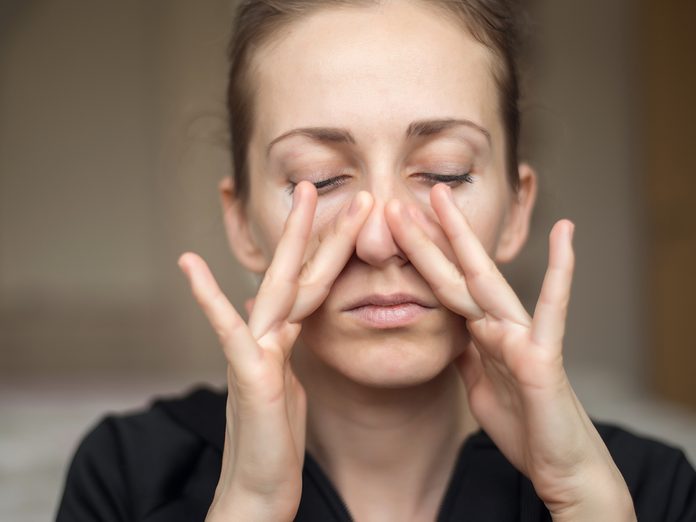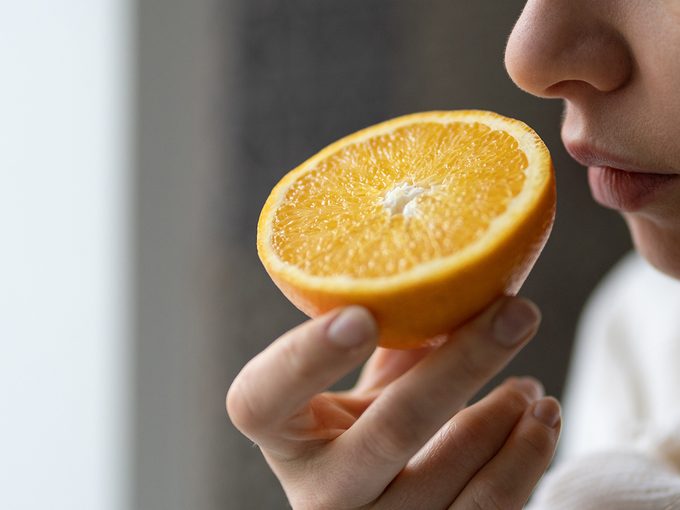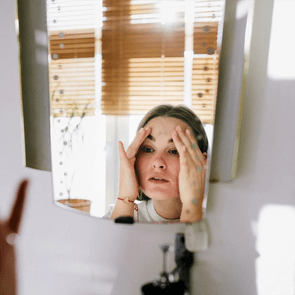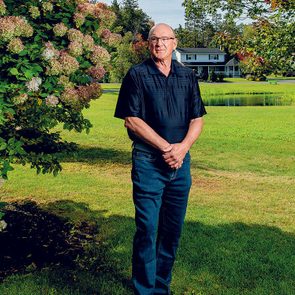The COVID-19 Side Effect That Distorts Your Sense of Smell

If pleasant odours now smell like rotting garbage, you could have parosmia—a condition linked to COVID-19. Here's how long it can last and how to cope.
The weird smell in your nose
It’s another unwelcome consequence of COVID-19 and it’s affecting relationships, triggering depression, causing weight loss, and just generally damaging the quality of life.
It’s called parosmia. This is when things smell different than normal, usually for the worse.
With parosmia, “a person may be looking at a rose but it smells like a burned piece of paper,” says Brent A. Senior, MD, professor of otolaryngology/neurosurgery at the University of North Carolina at Chapel Hill.
People have also reported the odour of rubber burning, garbage, sewage, mud, and food that tastes like gasoline. The world is no longer a familiar place.
Here’s everything you need to know about who gets parosmia, what causes it, and what can you do about it. (And here’s why some people are more likely to spread COVID-19 than others.)
Parosmia and viral infections
COVID-19 isn’t the only viral infection that seems to trigger parosmia. It’s been reported after cases of the cold, the flu, and other respiratory tract infections. (Here’s how to tell if your symptoms are COVID-19 or the flu.)
According to the organization Fifth Sense, a U.K. charity that supports those with smell and taste disorders, viruses account for as many as 12 percent of all cases of parosmia.
The symptom has also been linked with allergies, sinus infections, head injuries, exposure to certain toxins as well as neurological disorders like epilepsy.
But parosmia seems to be much more widespread with SARS-CoV-2, the virus that causes COVID-19, as does anosmia (total loss of smell) and hyposmia (reduced sense of smell), says Dr. Senior.
In one meta-analysis published in Rhinology in October, 47 percent of COVID-19 patients reported problems with smell. Dr. Senior estimates that smell aberrations, in general, occur at about half this rate for routine viral infections.
Parosmia numbers are hard to come by, but a June 2020 study in Chemical Senses found that a little less than 8 percent of COVID-19-infected patients reported parosmia. In other words, it’s pretty rare.
Anosmia and parosmia also seem to last longer with COVID-19, says Dennis Cunningham, MD, system medical director of infection control and prevention at Henry Ford Health System in Michigan.
It’s related to losing your sense of smell
COVID-19-related parosmia is more common among people who had earlier lost their ability to smell due to COVID-19.
Losing your sense of smell is a common symptom of COVID-19—sometimes the only symptom. In fact, it can be enough to warrant a diagnosis.
In outpatient populations with fairly low-gradeCOVID-19 symptoms, about half of patients lose their ability to smell. The number reaches nearly 100 percent in those who are hospitalized.

It’s probably not related to active infection
Parosmia tends to appear long after the SARS-Cov-2 virus has been cleared from your system, which typically takes 14 days. According to a February study in the journal Nature, patients started experiencing parosmia a median of two-and-a-half months after the initial symptoms.
No one knows exactly why this happens but it may be related to lasting damage to the olfactory nerves.
“COVID binds to particular receptors which are usually in the small intestine and the lung but are also in the support cells for the nerves involved in our sense of smell,” explains Dr. Cunningham. “The virus knocks out those support cells.” (Here’s what you need to know about coronavirus reinfection.)
It may be a sign of recovery
Parosmia may actually indicate that your nose is healing.
“It’s very common for patients to get better so oftentimes this tells us that the nerve is recuperating and regenerating [after anosmia],” says Dr. Senior, adding that about two-thirds of patients recover within about a month. A few, unfortunately, still have issues a year after their illness.
What can you do about it?
Time seems to be the best medicine when it comes to a fully functioning sniffer.
In the meantime, Fifth Sense recommends nasal douching as well as moving your head into different positions when you experience unpleasant and inaccurate smells.
Sometimes eating food at room temperature and avoiding spicy, fatty, or fried foods can provide some relief.
There are also smell retraining exercises. Specifically, popular smell training protocol, published in the journal The Laryngoscope, requires you to try and smell four different scents twice a day. Due to their distinct smell profiles, these include rose, eucalyptus, lemon, and cloves.
This has been known to work for those who’ve temporarily lost their sense of smell due to COVID.
“It’s like physical therapy for your nose,” says Dr. Senior. “It’s literally forcing yourself to smell certain odours for a couple of minutes every day and saying, “I know this is a rose.” It doesn’t smell like a rose but your brain needs to know it is.”
Sources
- MedRxiv: “Altered Smell and Taste: anosmia, parosmia and the impact of long COVID-19”
- Frontiers in Neurology: “Parosmia and Neurological Disorders: A Neglected Association”
- National Institute on Deafness and Other Communication Disorders: “Parosmia”
- British Medical Journal: “Sixty seconds on . . . parosmia”
- JAMA Network: “Evolution of Altered Sense of Smell or Taste in Patients With Mildly Symptomatic COVID-19”
- AbScent: “It Smells Disgusting! Parosmia and Phantosmia”
Next, check out the COVID-19 vaccination advice you need to know from an infectious disease specialist.






